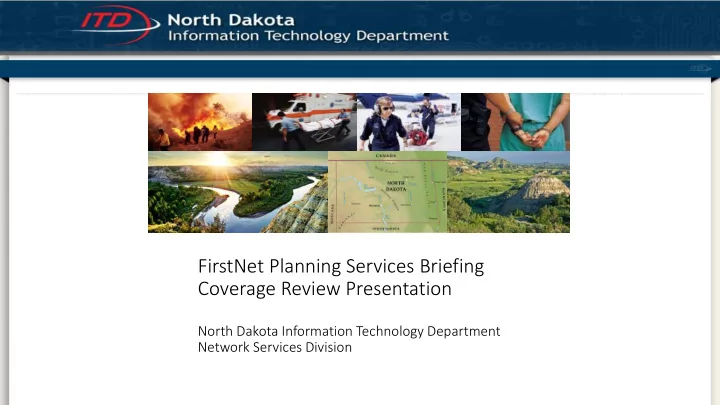

FirstNet Planning Services Briefing Coverage Review Presentation North Dakota Information Technology Department Network Services Division
Agenda • Introduction and purpose • Discuss your public safety requirements and needs – how do you leverage wireless data? and how do we make the solution more effective for your operations? • Interactive session: define coverage needs and identify assets • Broadband Case Study • Q&A on the Program
Introduction The Middle Class Tax Relief and Job Creation North Dakota FirstNet Services Project Act of 2012 • FirstNet • State awards a contract to Televate • to manage the program (October 20 MHz of spectrum for public safety broadband 2013) • Up to $7 Billion dollars • Project Scope: • Tasked to create the Nationwide – Governance Public Safety Broadband Network (NPSBN) – Education and Outreach • Public private partnership – Statewide Requirements Working • Built to public safety requirements Groups • – Public safety priority over Local Requirements - Coverage “secondary” users Assessments – Surveys: User Population & Utilization Requirements – Strategic plan development • State and Local Implementation Grant Program (SLIGP) • Captures each state’s requirements
Program Goals • FirstNet Goal: NPSBN service will be priced competitively with commercial carriers • Short term: Define minimum requirements for you to adopt FirstNet service for your mobile data requirements • Network will be improved and built out as it matures • At launch, NPSBN service will not replace your LMR radio • In the future, NPSBN service may be capable of replacing your radio • Lifecycle of incumbent systems, a major consideration • Presently, not a priority for MN FirstNet planning • Requires changes to the standards
Goal Today We will identify the level of coverage that would convince you to adopt the FirstNet service. • Do you use cellular data service today through a major carrier? Which do you use? Would you define this as your minimum requirement for adoption? • We are focusing on early, launch window requirements
Defining the MN-PSBN Service Types • Critical Priority Service Area (Highest Priority) • Where you want FirstNet coverage first and where you need it most (public safety grade service) • High-activity areas based on CAD data and other defined areas • Points of interest (critical infrastructure, anchor institutions, etc.) • Required Service Area “Need” • The minimal service area required to adopt the service • At minimum: compare to existing cellular service • Extended Service Area “Want” • Where commercial carriers do not cover, but where you need coverage • Where deployable or satellite is not acceptable
Why Coverage is Critical Stronger Signals Required Types of Coverage Impacts On Cost • Mobile: Vehicle based modem/router with external Mobile antenna • Outdoor Portable: same as above with operation outside the vehicle Outdoor Portable • In Vehicle Portable: handheld (smartphone/tablet), or PC based modem operated inside vehicle In Vehicle Portable • Indoor Portable: handheld (or equivalent) with additional losses incurred from walls/windows Indoor - 1 Wall • The more walls, density of construction, the more signal is required Indoor - Multi-wall Number of Cell Sites Required Per Square Mile It is critically important to understand the type of coverage required!
Why Coverage is Critical External Antenna Hand-held device No External Varying degrees of building loss Antenna Stronger Signal Required = more sites, more $$$
Coverage Assessment
Wireless Data Case Study Consider a recent major incident: • Describe the incident. • Did wireless data play a major role at the incident? – Describe the data system utilized at the incident. – If so, how? – If not, why not? • Were your responders satisfied with their data service? • How could the service have been improved to have resulted in a better outcome? • Which kinds of information flow to and from the incident could have resulted in a better outcome?
Closeout
Closeout • Other Needs: • What are your other requirements for the FirstNet service? • What other impediments and opportunities exist for FirstNet with your agency? • Is satellite acceptable? • Q&A • How can we improve this process?
Recommend
More recommend